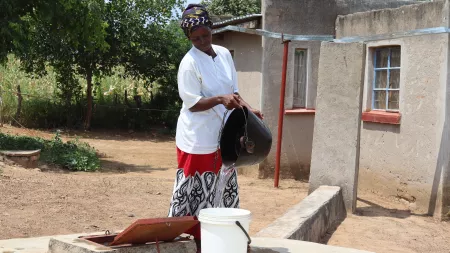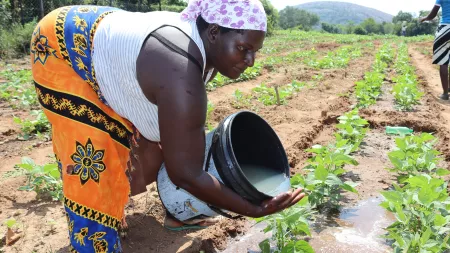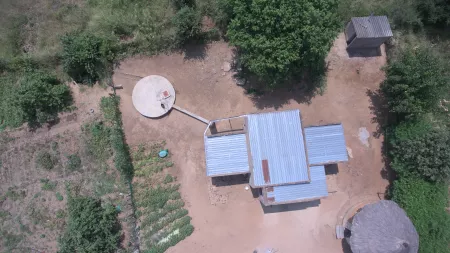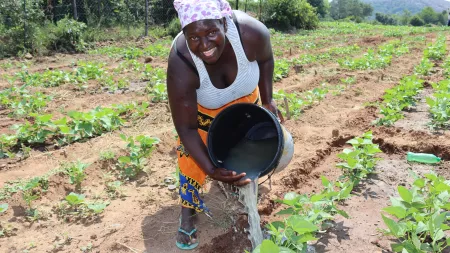Over the last two decades, rainfall variability has intensified in Zimbabwe due to climate change.
In rural Zimbabwe, rain-fed agriculture supports four out of five people, and from increasingly variable rainfall to economic volatility, complex and interconnected shocks and stresses have been devastating for communities, undermining their ability to care for and invest in their families.
Zimbabwe’s water woes have affected both urban and rural areas, leaving a vast majority vulnerable to a lack of access to clean water and waterborne diseases.
In the Mwenezi district, villagers like the mother of five Sheba Ngara (45) had no idea how to manage the water woes experienced in her community. Having to adapt to water scarcity was an uncommon phenomenon. Sheba explained that the nearest water sources, like nearby boreholes, had either broken down or dried up due to excessive use because of recurrent dry spells. This was leading to increased drudgery, forcing families to spend part of their productive time looking for water.

“Mwenezi is a very dry region, and before we joined the project we struggled with droughts and uncertainties in rainfall patterns which worsened our situation. We either got too little or too much rain. The water scarcity affected even the children and they were failing to concentrate on their schoolwork. Sometimes we collected rainwater in small buckets and dishes, but it was not enough, and it didn’t help us during dry spells. Together with our livestock, we had to walk very long distances to get clean water,” said Sheba Ngara.
For Sheba and other villagers in the Mwenezi district, cyclical droughts due to the impact of climate change had become a way of life, and many were forced to travel long distances in search of water.
Water harvesting and building resilience
Their ability to adapt to water shortages was improved thanks to the Zimbabwe Resilience Building Fund Enhanced Community Resilience and Sustainability (ZRBF-ECRAS) project led by CARE International; funded by the Ministry of Lands, Agriculture, Fisheries, Water and Rural Resettlement, Swedish Embassy, European Union, UNDP and the Foreign Commonwealth Development Office.
In 2016 Sheba became a participant in this project, working to help communities build and strengthen resilience capacities to withstand shocks and stresses in the face of climate change-induced adversities.
ZRBF-ECRAS, now in its sixth year, supports communities through training and assistance, using the layering, sequencing and integration approach of activities. This is where one household participates in a range of activities, from resilient climate-smart crop and livestock production, water harvesting technologies and fish farming, to post-harvest management and asset-based Village Savings and Lending (VSAL) aimed at improving communities’ absorptive, adaptive and transformative capacities.
52% of the program participants are women.

Sheba joined and took part in gender dialogues, village savings and lending, climate-smart agriculture and post-harvest management before receiving support to build a low-cost sustainable 10,000-liter water harvesting tank as an adaptation strategy to support her household in the drought-prone region.
This was welcomed by Sheba because in Zimbabwe’s rural areas cultural norms drive women and girls to usually bear the burden of water collection, and the time spent searching for water has a detrimental effect on their productive time and education respectively.
For her as the breadwinner, searching for water took a lot of her productive time.
Now the underground cement tank is helping with drinking water for her family and livestock as well as watering her nutrition garden.
There was a significant transformation of our lives because the scarcity of water also meant that we could not practice backyard farming. We needed money to buy vegetables for the family but now I have a nutrition garden on my homestead and I have water throughout the dry season.Sheba Ngara
The ZRBF-ECRAS project has constructed a number of individual and community water harvesting structures, totaling 120 underground tanks and three dams, to address water shortages for consumption, production, and livestock in the Masvingo Province.
50 families in Sheba’s village were supported with tanks and by a dam that holds 45,000 cubic meters of water.

The water flows directly into the two-hectare community nutrition garden which is supporting the community members with vegetables all year round.
Sheba says the dam has been a great benefit to the community, breaking the cycles of poverty and food insecurity that entrap the country’s most vulnerable communities. Additionally, through the village lending and savings scheme women in her village are now empowered in decision-making in the home.
“We no longer struggle as a community. Without water, there is no life. Our livestock no longer depends on traveling over 5km in search of water. In the past, we lost a lot of livestock due to theft and crocodiles in some of the distant water sources they had to travel to. We now have good nutrition and we can sell excess vegetables and get money for our village lending and savings as well as for school fees. Others are planning to venture into fish farming to increase income streams,” Sheba said.
